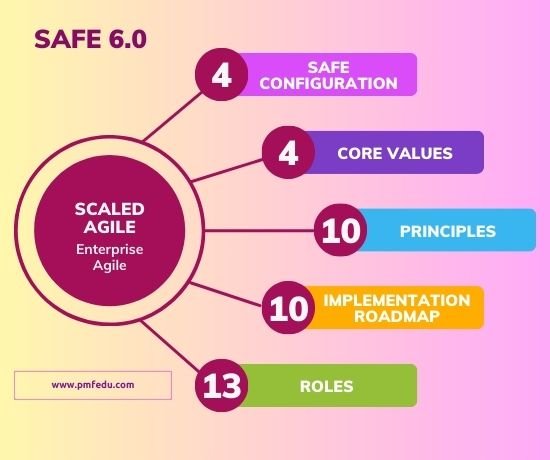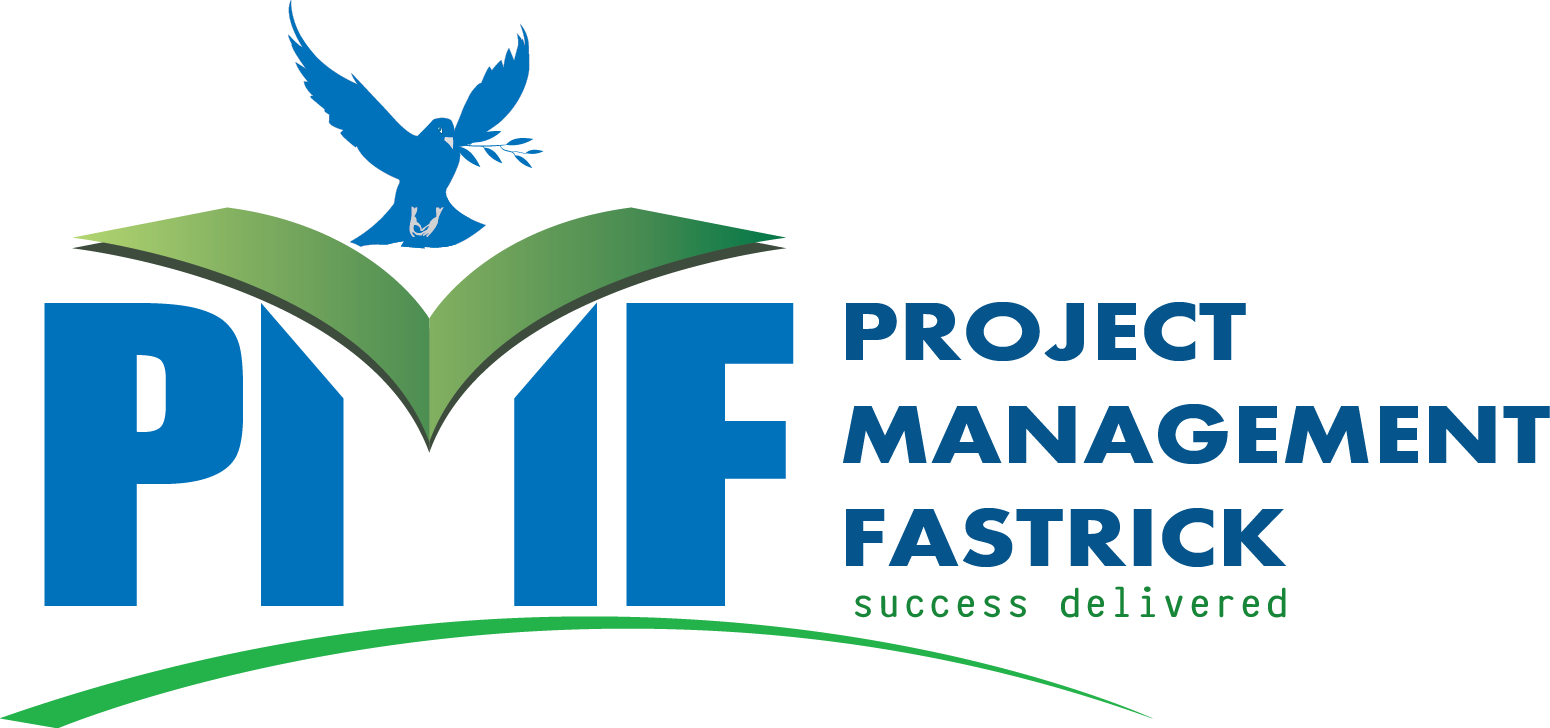SCALED AGILE
Empower Your Enterprise with Scaled Agile SAFe® – Streamlining Collaboration and Accelerating Delivery.
Click Here

Scaled Agile Framework : A Comprehensive Guide
The Scaled Agile Framework (SAFe) is a robust framework designed to help organizations scale agile practices across multiple teams, departments, and portfolios. As agile methodologies like Scrum and Kanban have become the norm for software development teams, organizations often struggle to extend these practices across the entire enterprise. SAFe 6.0 addresses this challenge by providing a structured approach that aligns team-level agility with strategic objectives, ensuring the entire organization moves in sync.
What is SAFe 6.0?
SAFe 6.0 is the latest iteration of the Scaled Agile Framework, incorporating updated practices and guidance to help organizations achieve business agility. SAFe is built on four core configurations:
- Essential SAFe: Focuses on the fundamental elements required for a successful implementation of SAFe. It includes Agile Release Trains (ARTs), which are the core of SAFe.
- Large Solution SAFe: Designed for organizations that need to coordinate across multiple ARTs but don’t require portfolio-level coordination.
- Portfolio SAFe: Adds portfolio management and lean governance, aligning execution with business strategy.
- Full SAFe: The most comprehensive configuration, combining all elements of SAFe, ideal for large enterprises with extensive needs.


Core Values of SAFe 6.0
SAFe is built on four core values that guide its implementation:
- Alignment: Ensuring that everyone in the organization is moving towards the same strategic goals.
- Built-in Quality: Maintaining high standards of quality throughout the development process.
- Transparency: Promoting openness and visibility into all aspects of the development and delivery process.
- Program Execution: Focusing on delivering value continuously through successful execution of programs and projects.
10 SAFe Principles
- Take an economic view: Understand the economic impact of decisions and optimize for value.
- Apply systems thinking: View the organization as a system to improve processes and outcomes.
- Assume variability; preserve options: Embrace uncertainty and keep options open until the last responsible moment.
- Build incrementally with fast, integrated learning cycles: Develop in small increments with regular feedback.
- Base milestones on objective evaluation of working systems: Use objective measures to assess progress.
- Visualize and limit work in progress, reduce batch sizes, and manage queue lengths: Optimize flow and reduce delays.
- Apply cadence, synchronize with cross-domain planning: Use regular intervals to align teams and ensure coordination.
- Unlock the intrinsic motivation of knowledge workers: Empower teams by providing autonomy and purpose.
- Decentralize decision-making: Allow teams to make decisions quickly to maintain momentum.
- Organize around value: Structure teams and programs to deliver the most value to the customer.


SAFe Implementation Roadmap
Implementing SAFe is a journey that requires careful planning and execution. The SAFe Implementation Roadmap outlines a series of steps to guide organizations through this process:
- Reaching the Tipping Point: Recognizing the need for change and gaining leadership support.
- Train Lean-Agile Change Agents: Preparing internal champions to lead the transformation.
- Train Executives, Managers, and Leaders: Ensuring leadership understands and supports the SAFe transformation.
- Identify Value Streams and ARTs: Mapping out how value flows through the organization and structuring Agile Release Trains accordingly.
- Create the Implementation Plan: Developing a roadmap for rolling out SAFe across the organization.
- Prepare for ART Launch: Setting up the initial Agile Release Train.
- Train Teams and Launch ART: Training teams in SAFe practices and launching the first ART.
- Coach ART Execution: Providing ongoing support to ensure successful ART execution.
- Launch More ARTs and Value Streams: Expanding the SAFe implementation across the organization.
- Sustain and Improve: Continuously refining and improving the implementation to maximize value.
Roles & Events in SAFe 6.0
SAFe 6.0 defines several roles, each with specific responsibilities:
- Agile Teams: Cross-functional teams that deliver value incrementally.
- Product Owner (PO): Manages the team backlog and ensures alignment with customer needs.
- Scrum Master/Team Coach: Facilitates team processes and ensures adherence to agile practices.
- Release Train Engineer (RTE): Serves as the chief Scrum Master for the Agile Release Train.
- System Architect/Engineer: Provides technical guidance and ensures the architectural integrity of the solution.
- Product Management: Owns the program backlog and prioritizes features for development.
- Business Owners: Key stakeholders who ensure alignment between business strategy and execution.
SAFe Events
SAFe 6.0 prescribes a series of events to ensure continuous alignment and progress:
- PI Planning: A two-day event that aligns teams on the vision, objectives, and deliverables for the upcoming Program Increment (PI).
- ART Sync: Regular meetings to review progress, discuss dependencies, and address issues.
- System Demo: A demonstration of the integrated work delivered by the ART during the PI.
- Inspect and Adapt: A retrospective at the end of each PI to identify improvement opportunities.

F.A.Q.
FAQs prepared by Experts at PMF Edu, provide quick, accessible answers to common questions, helping users understand key concepts and navigate processes more efficiently.
SAFe is a framework designed to help organizations scale agile practices across multiple teams, departments, and levels, enabling enterprise-level agility.
SAFe is built on four core values: alignment, built-in quality, transparency, and program execution.
An ART is a long-lived team of Agile teams, typically 5-12, that plan, commit, develop, and deploy together to deliver value.
The RTE is a servant leader and coach for the Agile Release Train, facilitating program-level processes and execution, managing risks, and driving continuous improvement.
SAFe uses Weighted Shortest Job First (WSJF) to prioritize the backlog by considering both the business value and the cost of delay.
PI (Program Increment) Planning is a collaborative event for aligning all teams on the ART for the next increment, while Iteration Planning is conducted by individual teams to plan work for a specific iteration.
SAFe promotes the use of DevOps practices by integrating continuous integration, continuous deployment, and release on demand into the development pipeline.
Lean-Agile leaders foster a culture of innovation, learning, and continuous improvement, guiding teams to apply Lean and Agile principles effectively.
SAFe provides a Lean Portfolio Management (LPM) approach, aligning strategy with execution by funding value streams and ensuring governance through a Portfolio Kanban.
SAFe helps organizations achieve faster time-to-market, improved product quality, higher productivity, and increased employee engagement by scaling Agile principles across the enterprise.
SAFe addresses this challenge through the use of Solution Trains, which coordinate multiple ARTs working on large, complex solutions. The Solution Train uses a cadence of synchronization points, including Pre- and Post-PI Planning events, to align vision, architecture, and dependencies across ARTs, ensuring that they deliver cohesive and integrated solutions.
Implementing SAFe in an organization with legacy methodologies involves a structured change management approach. SAFe encourages starting with a Value Stream identification workshop to map the existing processes and flows, followed by incremental adoption of SAFe principles. This may include launching an Agile Release Train with key teams while maintaining some Waterfall practices in parallel, progressively transitioning the entire organization to SAFe practices.
In SAFe, System Architects/Engineering plays a critical role in maintaining the architectural runway, which is the necessary technical infrastructure to support upcoming features. They must balance immediate feature delivery with the need for sustainable development by incrementally building the runway through continuous exploration, leveraging architectural epics, and using architectural enablers to address non-functional requirements without disrupting the flow of features.
SAFe ensures alignment through a hierarchical structure of objectives and backlogs: strategic themes at the portfolio level guide the vision, which cascades down to value streams, ARTs, and teams. PI Objectives, business epics, and enablers are used to align work at every level, with regular synchronization events such as PI Planning and Inspect and Adapt workshops to recalibrate and ensure that team execution aligns with strategic goals.
SAFe integrates Lean practices like value stream mapping, flow optimization, and waste reduction with Agile methodologies to ensure value delivery. This is done through Lean-Agile budgeting, where funding is allocated to value streams rather than projects, and by applying Lean principles such as pull-based systems and continuous improvement at every level. SAFe’s emphasis on DevOps and continuous delivery pipelines also ensures that value is delivered incrementally and efficiently, minimizing delays and optimizing flow across complex enterprise structures.
Business Value Delivered: Measures the value of the work completed by the teams as assessed by the business stakeholders. It often uses Program Increment (PI) Objectives to track progress and success against business goals.
Predictability: Tracks how reliably teams and ARTs can deliver on their commitments. This is often measured through the Program Predictability Measure, which compares planned versus actual business value delivered.
Time to Market: Measures the speed at which a product or feature can be delivered from concept to production. This includes metrics like cycle time and lead time, which are essential for understanding the efficiency of the development process.
Quality: Assesses the quality of the product being delivered, using metrics such as defect density, escaped defects, automated test coverage, and customer satisfaction ratings.
Release Frequency: Tracks how often teams and ARTs release increments of value to customers. A higher release frequency generally indicates greater agility and responsiveness to market changes.
Employee Engagement: Measures the satisfaction and engagement of team members within the organization. This can be assessed through regular surveys, turnover rates, and participation in continuous improvement activities.
Flow Efficiency: Analyzes the ratio of active work time versus wait time within the development process. High flow efficiency indicates a smooth, uninterrupted value stream with minimal delays.
Innovation Rate: Measures the proportion of time and resources dedicated to innovation, often reflected in the number of new features, improvements, or experiments delivered during a Program Increment.
Cost of Delay: Evaluates the financial impact of delaying work on high-priority features or capabilities. It helps prioritize tasks based on their economic value to the business.
Lean Portfolio Metrics: Includes metrics such as Return on Investment (ROI), Net Promoter Score (NPS), and Budget vs. Actual Spend, providing insights into the overall financial health and strategic alignment of the portfolio.



